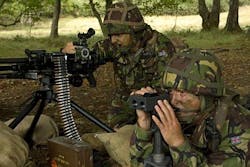Marines ask four electro-optics companies to build rugged handheld laser targeting systems
QUANTICO, Va., 8 Nov. 2012. The U.S. Marine Corps. is asking four military electro-optics companies to develop handheld tactical laser rangefinders small enough for one infantryman to carry that would help deployed Marines detect, identify, and pinpoint targets during the day, at night, and in bad weather.
The Marine Corps Systems Command at Quantico Marine Base, Va., is awarding contracts to the Raytheon Co. EO Innovations business unit in Richardson, Texas; Elbit Systems of America in Fort Worth, Texas; Jenoptik Defense Inc. in Jupiter, Fla.; and BAE Systems OASYS in Manchester, N.H., to develop the Common Laser Range Finder Integrated Capability (CLRF IC) system.
The CLRF IC system will weigh no more than three pounds -- light enough for one Marie infantryman to carry -- and will provide improved integrated night-vision capability, internal selective availability anti-spoofing module (SAASM) GPS, and non-magnetic azimuth capability.
Raytheon will receive a $3.3 million contract; Elbit will receive a $4.3 million contract; Jenoptik will receive a $1.3 million contract; and BAE Systems OASYS will receive a $2.1 million contract.
Each contract is for 19 months. The CLRF IC system will replace the Marine Corps's currently fielded CLRF suite of equipment. The new CLRF IC system will provide reduced weight, enhanced precision, improved night-vision capability, and improved non-magnetic azimuth capability by incorporating components of the CLRF suite into one system.
The CLRF IC will be a handheld lightweight man-portable GPS target location device to assist the operator in determining the location of a target or other object of interest by measuring the distance, direction, and vertical angle from the operator to the object. The CLRF IC system also can export these measurement in digital format to external digital devices for further processing.
The CLRF IC also can operate in the daytime and at night, as well as in the range of environments in which the Marines deploy with laser spot imaging of several wavelengths, Marine Corps officials say.
For more information contact Raytheon Space and Airborne Systems online at www.raytheon.com/businesses/rsas; Elbit Systems of America at www.elbitsystems-us.com; Jenoptik Defense at www.jenoptik.com; BAE Systems OASYS at www.baesystems.com, or Marine Corps Systems Command at www.marcorsyscom.marines.mil.
